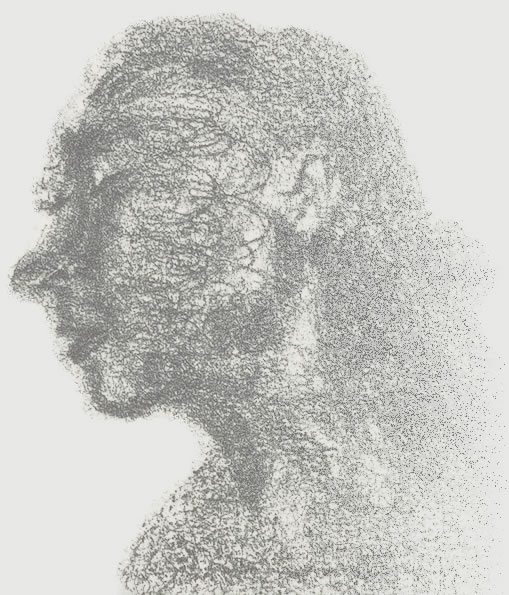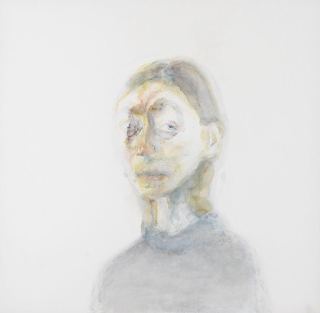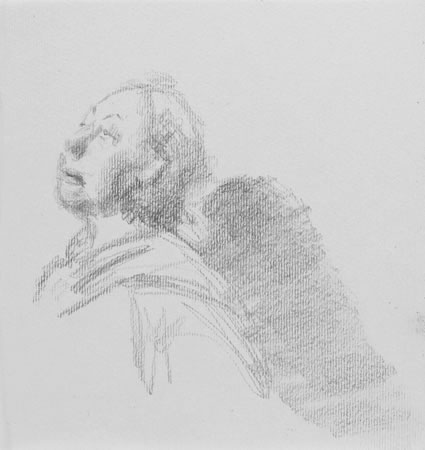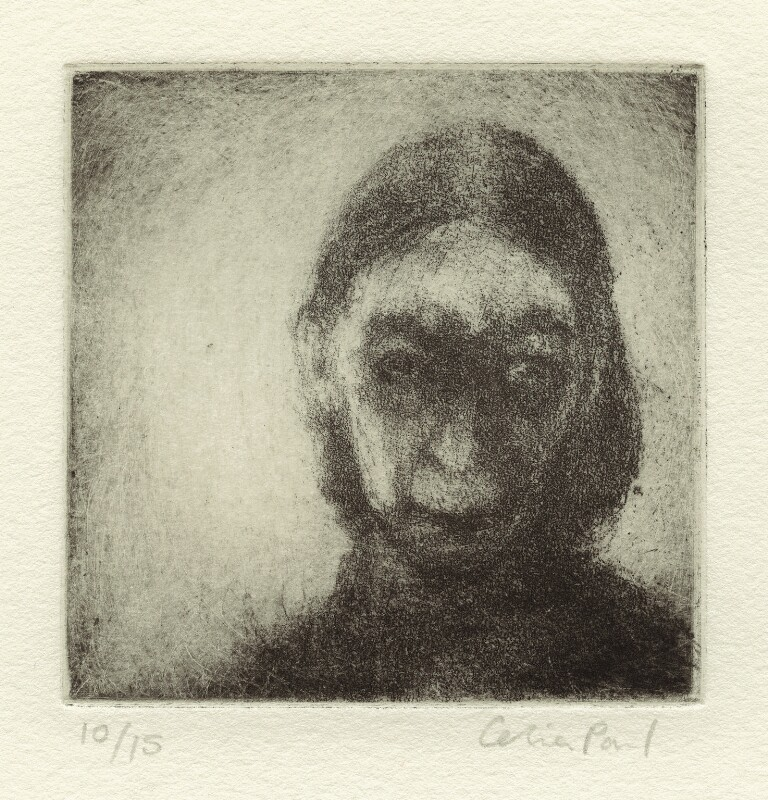
I recently wrote a post about a small Celia Paul etching I came across in the Marlborough Gallery. I have since been looking at her drawings and amongst several very different images found the self portrait drawing above. I really find it fascinating, as it has echoes of some of the things I have been trying to do myself. The head feels as if it could be made out of mixing and flowing gases, different textural energies merge into each other, so that the head appears to drift into visibility. At the same time it is still a head, the eyes seem shut and a moment of stability occurs around the ear. As the head twists away from me, I decide something in my own mind about the internal gaze of this shut eyed figure; thinking that what it is doing is in some way asserting its own internal gaze over my own. It is powerful without having to be constructed with all the usual signs of power. Instead of making a drawing of a head as solid as a rock, by drawing it from a low viewpoint, carving it out with tonal masses or by using cross contour lines, this portrait arrives by using fumage like techniques. I have been asking myself, how do you draw energy? How do you draw a body and at the same time reflect on it as a particular set of events that emerge out of and back into the energy flow? This drawing seems to pulse with psychic energy and has a presence, so becomes for myself, a pointer, an indication of a possible direction to take.
The issue of 'presence' and what that actually is, is another of those conundrums that has been on my mind recently. What type of presence can you give to someone or something that is depicted within an image? How does it relate to the actual presence of the person or thing portrayed? Celia Paul is unfortunately sometimes known more for her relationship with Lucien Freud than for her own work, Gwen John was initially known more as a model or 'muse' in relation to the much more famous Rodin. Gradually over the years Gwen John has been seen less and less as a lover of Rodin and more and more as an important artist in her own right. This reflects a shift in society and what was at one point seen as a series of attributes of the 'feminine' and therefore not important, is now read in a very different way. The 'quiet' portraits of Gwen John, express dignity, the importance of an inner voice and calm control. The curve that the composition below is based on, is rather like a strung bow, it is taut and full of controlled energy. The 'presence' of the sitter is undoubted, but it is not the type of presence you associate with the grand portrait tradition of important people. This painting acknowledges and presents the presence of a mortal soul, one that still manages to project a distinct aura, despite a lack of bravura paint energy. In fact the energy pulse comes from the restricted palette, the greys that surround the face and hands, allowing the subtle warms of perceived skin tones, to glow with life.

Gwen John: Chloë Boughton-Leigh: Leeds City Art Gallery
When you look at Gwen John's drawings you also see this observation of quietness. The fragility of life is glimpsed in her portraits of other women and girls, but it is not a weak fragility, it is one maintained via a steely resolve that sits beneath a quiet exterior.
Gwen John: Study of a girl
Gwen John: Study of a child
Celia Paul has a similar tough fragility. I like the way that she stares back at you from these drawings. She knows the value of her own presence, she doesn't need to glorify her existence, it simply is.
Celia Paul: Self portrait: 2007
Celia Paul: Self portrait: Watercolour and coloured pencils
Celia Paul's self portrait, made with watercolour and coloured pencils above, not only 'just exists' or floats into being, it seems to balefully stare out as if acknowledging her own uneasiness about being an artist. This soft almost not there presence, after a while becomes rather uncomfortable to look at; she seems to ask, "What are you looking at?" Her presence defiantly present in what is such an initially insubstantial seeming image.
Curtis Holder was the 2020 winner of the Sky Arts Portrait Artist of the Year competition. A televised competition that I have previously criticised for being about television and not painting or drawing. Even so I think it is worth looking at some of Holder's drawings, as I believe he is an artist that has managed to come through because of real merit, his work holding up on the TV screen as well as in the flesh. In the context I'm writing about today, it is in the way he draws what I am beginning to think of as energy fields, or how to draw light as both particle and wave, that interests me. He is also drawn to Gwen John as an artist and has made a portrait of her.
Curtis Holder: Gwen John: 2021
Holder's portrait of Gwen John is one of those images that emerges from a flickering 'rain' of lines. He must have worked from a flat image, as Gwen John is long dead, but he raises her back into being by discovering her image in these lines as they cut through the surface of his paper. I am slightly worried about the dark line that curves around an edge of hair, it feels as if it is a leftover from an earlier approach, (one you can also see outlining the shoulders) but besides that I think the drawing is an excellent approach to making a homage of an artist that has obviously had an influence on him.

The best of Holder's drawings have a quality that allows you to hold mass and energy as two things in your mind at once, in particular I thought the way that the orange of the what I think is a self-portrait below, drifted out into the space around the figure, was an interesting device, as it added an alternative way of dealing with time. The pale residue of orange powder, (I presume it is from faint dustings of pastel, but as I haven't seen the actual drawing it could be traces of a watercolour wash) sits next to the heightened intensity of his orange pullover, in a similar way to an afterimage. Not as an optical opposite, but as a suggestion of an orange moving through space, of a former existence.
Curtis Holder
The soft orange in the image above I also began to read as a sort of ghost, and it reminded me of another small drawing of Celia Paul's, 'Mandy with wings'.
Celia Paul: Mandy with wings 2007
Her drawing 'Mandy with Wings' is a beautiful small reminder of how to find magic in the everyday. I suspect the wings that Mandy now has in this image were initially Mandy's shadow cast onto a wall behind her, but Paul has seen another possibility and in the tilt of the head and suggestion of a monk's habit made by a couple of lines traced over Mandy's shoulder, a delicate spiritual idea has floated into being.
Celia Paul: Mother with clasped hands 2007
In Paul's drawing of her mother with clasped hands above, the 'punctum' for myself is the dark line that stretches from her mother's neck down to her hands. It's like a scar that cuts the figure in two. The vertical lines of the laid paper reinforce the thinness of the image and the hand clenching the other hand's fingers, suggests a nervous awareness of a situation that the eyes can barely look at. I found another drawing of Paul's mother on a scrap of torn paper, its informality suggesting that she didn't want to make too much of the situation, a note made in a moment, perhaps in such a way that she didn't disturb her mother. Perhaps I'm reading my own narrative into the drawing, as I well remember how other people used to react if I decided to draw them, it always seemed such an intrusion, so I tended to make drawings of people surreptitiously.
Celia Paul: Mother
Celia Paul also draws using watercolour and etching. Again I found her approach fascinating. Whoever Mandy is, Celia Paul seems to be able to find the spiritual in her. In this instance, 'Mandy in Sunlight' she gives her friend a yellow halo, and the 'sunlit head' below, which I presume is also an image of Mandy, suggests even deeper spiritual awareness, closed eyes in both cases intimating the presence of someone who is deeply concerned with her inner world.

Celia Paul: Mandy in sunlight
Celia Paul: Sun lit head
In the small etching below it is Paul that stares out at us again, her face off centre, unable to 'face' filling the frame, somehow avoiding direct face to face contact, yet at the same time able to stare you out. One eye slightly lower than the other, the image emerging like others out of a haze of marks, this time the ones that an etching plate allows you to make, especially when it is wiped by hand.
Celia Paul: Self-portrait Etching
See also:















No comments:
Post a Comment